Wolf packs are deadly hunters that wear out their large prey with attacks until they can’t fight back. A pride of lions is just as comfortable springing an ambush as they are attacking prey for several minutes. Although these two creatures don’t share a range, we want to imagine what would happen if they did. Would a battle between a super pack of 50 wolves and a pride of lions favor the big cats or the canines?
We’re going to break down this fight using information from the largest extant wolf species along with lions. We’ll show you how each animal compares individually and then add their numbers into the battle to come to a reasonable conclusion about this fight.
Comparing a Wolf and a Lion
| Wolves | Lions | |
|---|---|---|
| Size | Weight: from 80 to 150 pounds Height: from 2.2 to 3 feet Length: 3.4 to 5 feet long | Weight: average 260 to 550 pounds Height: between 3 and 3.9 feet tall Length: from 4 to 7 feet long |
| Speed | – From 30 to 40 mph | – Can run 35 mph for medium distances, but can reach speeds of 50 mph |
| Defenses | – A wolf pack is the first line of defense for many wolves – The wolf’s speed helps it escape from harm – Powerful senses allow wolves to find prey and avoid danger | – Protected by the size and strength of their pride – The size and strength of a lion make them difficult to take down – Can escape from dangerous situations with its speed |
| Offensive Capabilities | – Bite force that could be as low as 400 PSI or as high as 1,000 PSI – Has 2-inch teeth to deliver bites – Also has somewhat sharp claws with which to attack | – Has a powerful bite that measures between 650 and 1,000 PSI – Canine teeth measure about 3 to 3.9 inches long – Have 1.5-inch-long claws that they use to help them attack prey – Will attack their prey’s neck |
| Predatory Behavior | – Cursorial predation where the wolf pack hunts, injures, wears down and kills their prey | – Often hunt with their pride to take down large prey – May use endurance predation or ambush predation |
What Are Two Key Differences Between 50 Wolves and a Pride of Lions?
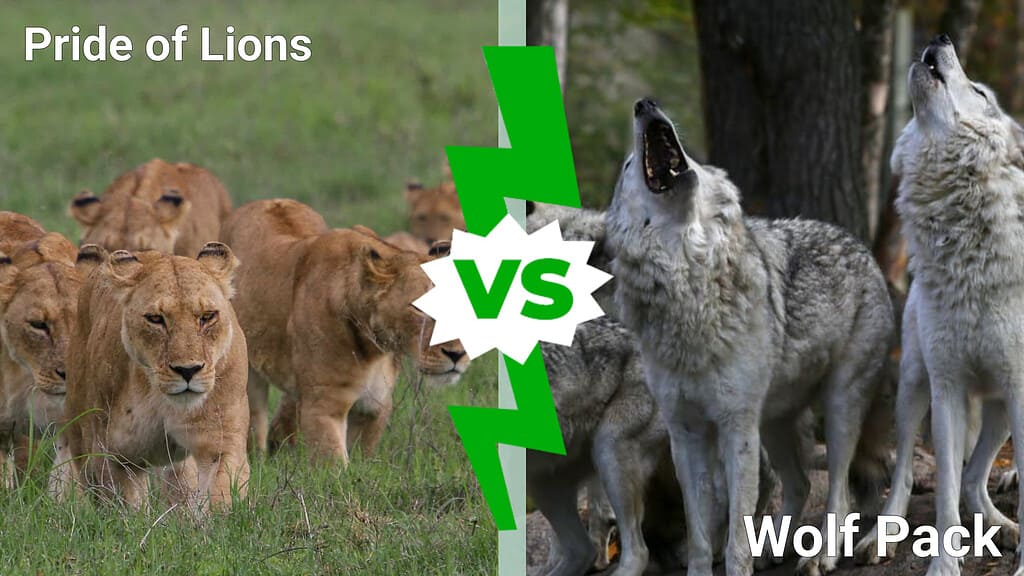
The most significant differences between 50 wolves and a pride of lions can be found in the size of the animals and the number of members in their groups. The average pride of lions can measure anywhere between 3 and 40 members, and the animals weigh up to 550 pounds, stand 3 to 3.9 feet tall, and grow from 4 to 7 feet long. Meanwhile, this super wolf pack has 50 members and each creature weighs between 80 and 150 pounds, stand about 2.2 to 3 feet tall, and grows about 5 feet long or slightly more.
All in all, the lions are bigger and deadlier on an individual level, but it’s hard to discount the effect that the number of fighters have on this epic battle. We need more information before making a decision.
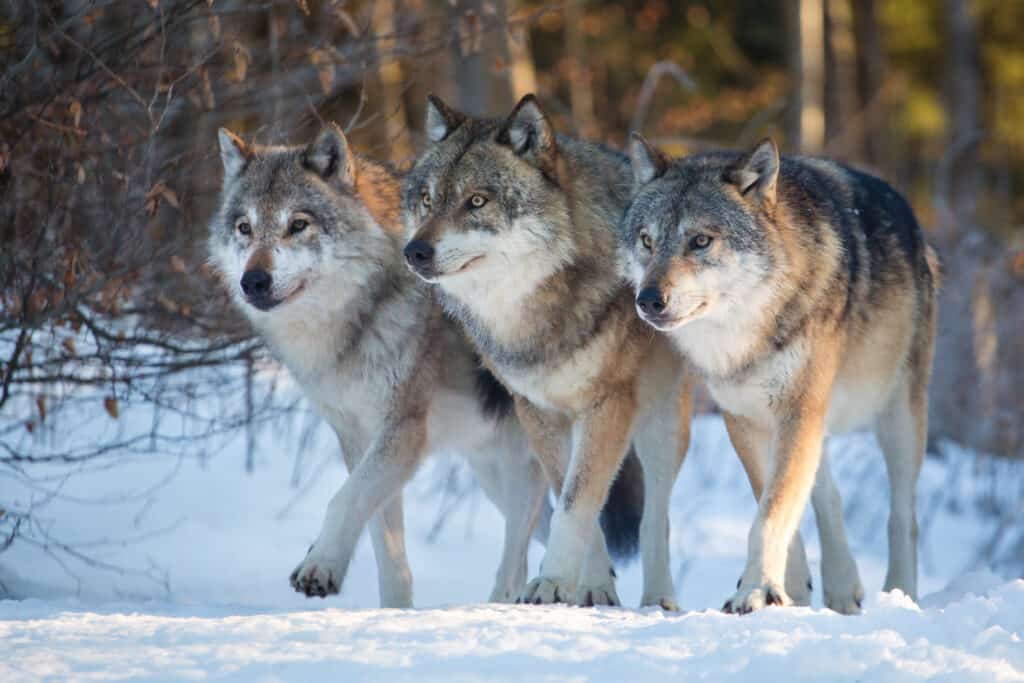
Wolves have powerful senses that allow them to find prey and avoid danger.
©David Dirga/Shutterstock.com
What Are the Key Factors in a Fight Between 50 Wolves and a Pride of Lions?
The key factors in the fight between 50 wolves and a pride of lions include the individual animals’ size, offensive powers, and predatory behaviors. However, we need to include all the relevant data.
We’re going to examine five points of data, determine which animal has the bigger advantage in each area, and use that information to come up with an accurate depiction of how this fight would go down.
50 Wolves vs. Pride of Lions: Size
The average lion is much larger than the average grey wolf. A lion can weigh anywhere between 260 and 550 pounds while standing between 3 and 3.9 feet tall and growing up to 7 feet long. The average wolf only weighs about 80 to 150 pounds, stands up to 3 feet tall, and grows between 3.4 and 5 feet long.
Needless to say, the average lion is much bigger than a single wolf, so they have a significant advantage in this fight.
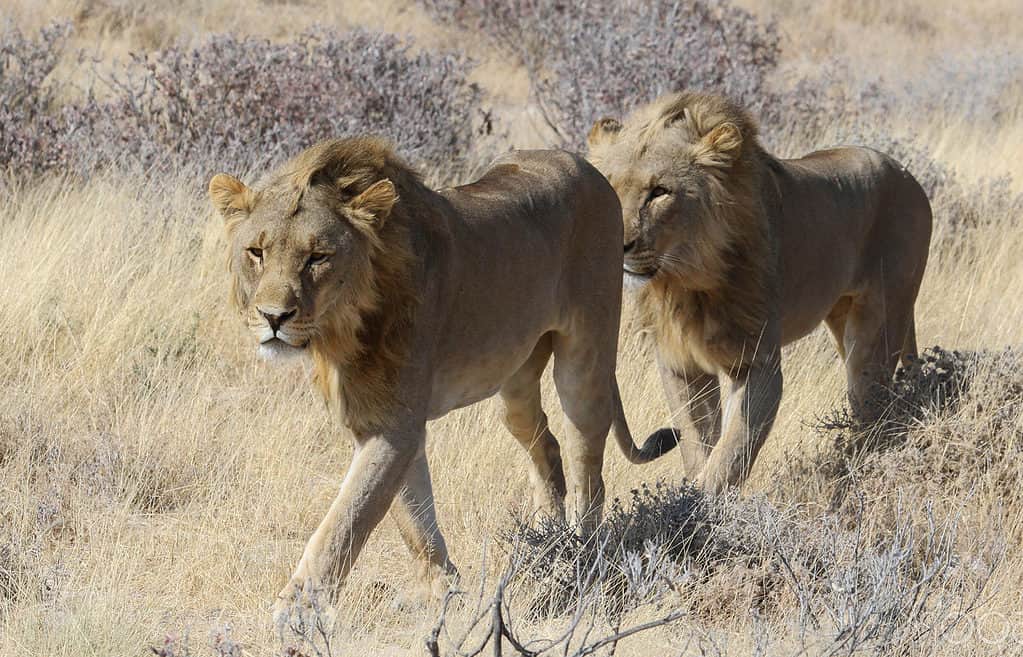
The average lion is much larger than the average wolf weighing anywhere between 260 and 550 pounds.
©Wirestock Creators/Shutterstock.com
50 Wolves vs. Pride of Lions: Speed
Although they’re larger and heavier, the average lion can reach higher speeds than the average wolf. Both creatures tend to run anywhere between 30 and 40 mph, but the lion can reach a top speed of about 50 mph when closing in on its prey.
That burst of speed can give the lion an edge when attacking other creatures. However, that won’t be enough to escape a pack of wolves.
Nevertheless, the lions have a speed advantage in this fight.
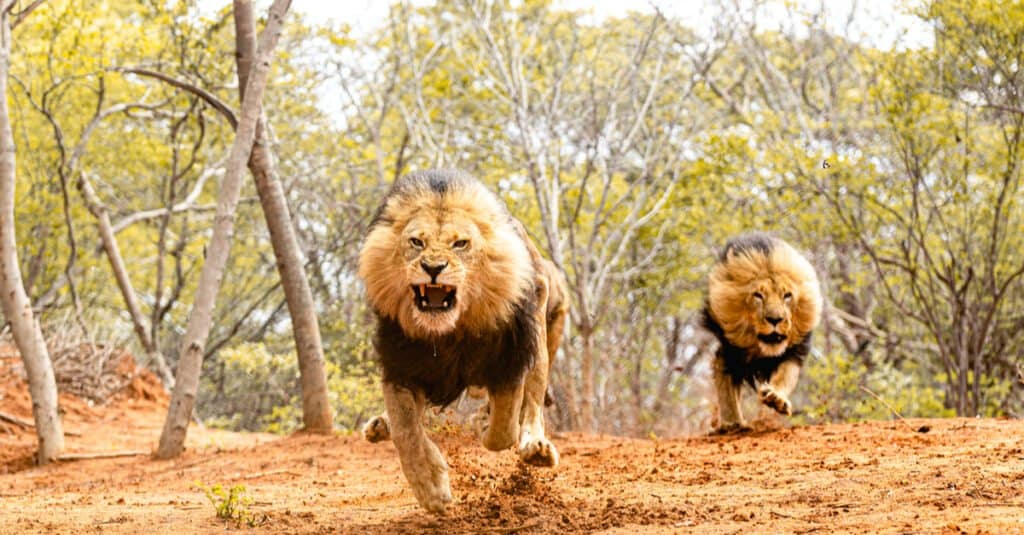
Lions can reach higher speeds than the average wolf running between 30 and 40 mph with a top speed of about 50 mph when chasing prey.
©Blue Slate Films/Shutterstock.com
50 Wolves vs. Pride of Lions: Defenses
Both wolves and lions depend on the presence of their pack or pride members to keep them safe. They find safety in numbers, and that ensures they can live and hunt with one another.
Individually, wolves don’t have a lot going for defenses. They can run from situations that don’t favor them. Lions can also flee using their speed, but they are also massive and powerful animals that are very difficult to take down in a fight. Physically, some lions have a mane that protects them from bites to the neck.
All in all, the lion’s size gives it an edge in terms of defense.
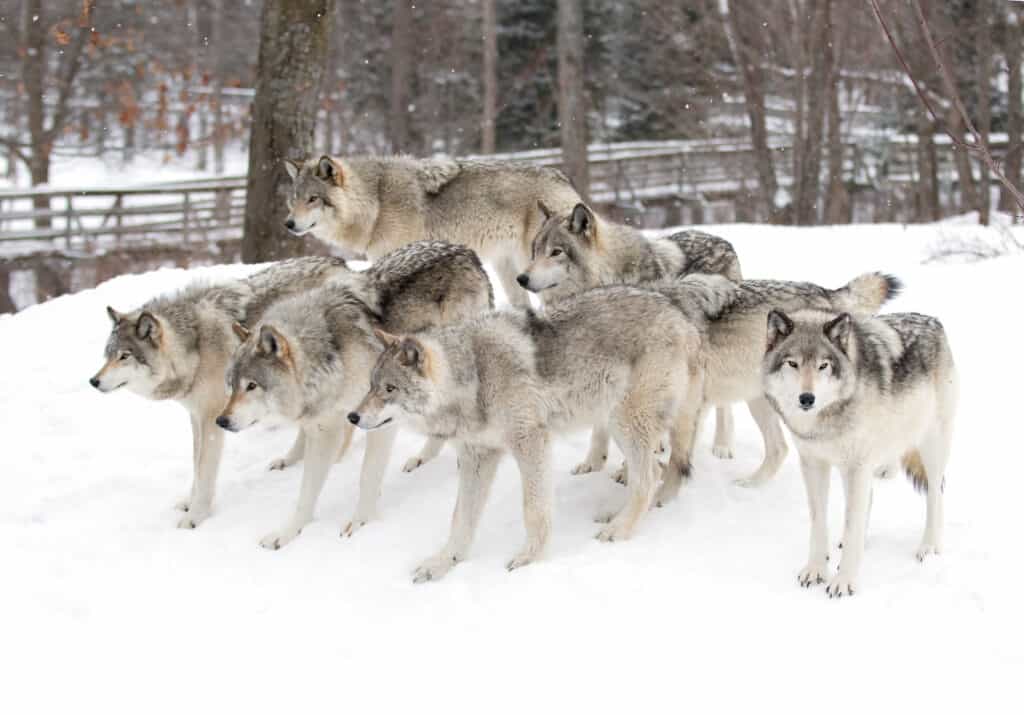
Both wolves and lions depend on the presence of their pack or pride members to keep them safe.
©Jim Cumming/Shutterstock.com
50 Wolves vs. Pride of Lions: Offensive Capabilities
Lions are far deadlier attackers than wolves. A single lion can take down prey much larger than itself with a single vicious attack. Lions have a bite force that could be as high as 1,000 PSI along with canine teeth that measure almost 4 inches long. Their raw power and weight allow them to bring prey to the ground with ease while also aiming for a precise attack on their prey’s neck.
Wolves are dangerous too. They bite with a force that has been measured at 400 PSI and is rumored to be much higher in the wild. Their canine teeth measure about 2 inches long, more than enough to allow them to kill smaller prey. They also have reasonably sharp claws that they can use to attack or climb on their prey. They can take down larger prey than themselves, but they rely on their hunting pack to share the ordeal.
All in all, the lion has an offensive advantage in this fight.
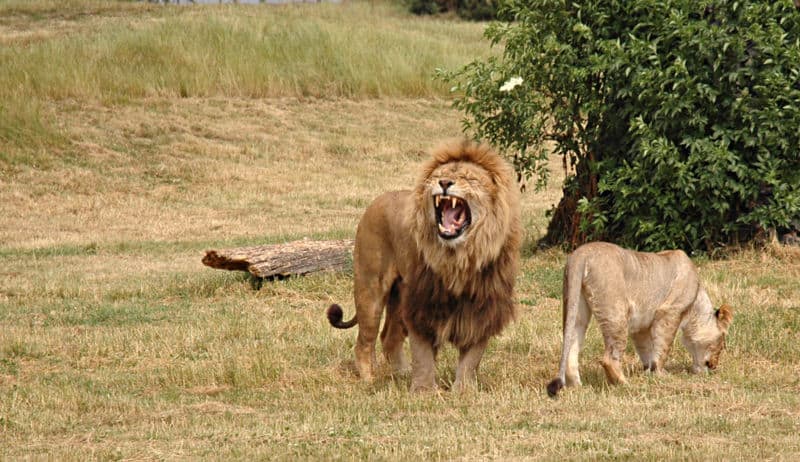
Lions are far deadlier attackers than wolves with a bite force that could be as high as 1,000 PSI along with 4-inch teeth.
50 Wolves vs. Pride of Lions: Predatory Behavior
Wolf packs are known for their cursorial predation style. That is when they chase down their prey, destroy its will to fight by inflicting wound after wound while chasing them, and then kill the prey when it’s too tired to fight back.
Lions are interesting in that they can use a cursorial predation style to work together with several others to take down large prey, but they can also ambush prey when hunting in small groups or alone.
The lions have an advantage because of their versatility in this situation.
Who Would Win in a Fight Between 50 Wolves and a Pride of Lions?
The pack of 50 wolves would win a fight against a pride of lions. That holds true even though lions have most of the advantages in this fight.
The average lion pride size measures between 3 and 40 animals. A 40-member pride would win, but that’s skewing the average too much. Most prides are a lot smaller.
The prides in Kruger National Park average about 13 lions. Not all of the lions in a pride are fighting age and ready to take on wolves, though. An average of 5 lions would be juveniles or cubs, giving the lion pride 8 members with which to fight. That means that every adult lion would need to face about 5 or 6 wolves.
Now, you may have seen the video where one lion holds off 20 hyenas alone. That lion was not going to survive that encounter forever. The hyenas were wearing it down quickly, and they could have moved in for the kill within minutes if not for the intervention of the other lion that came to its rescue.
That would be the case here. The lions would have to flee this fight if they wanted to live. The individual wolves would wear down the lions, attacking them in vulnerable areas again and again. They know that their superior numbers mean the lions can’t afford to go on the offensive without opening themselves to deadly attacks. As long as they keep moving and biting, the lions have to take it until they can counter.
The lions would die if they stood their ground. However, they would probably take at least a few wolves with them as they perished. If we re-calculated this fight with 15 adult lions, the wolves would probably be the ones fleeing and dying.
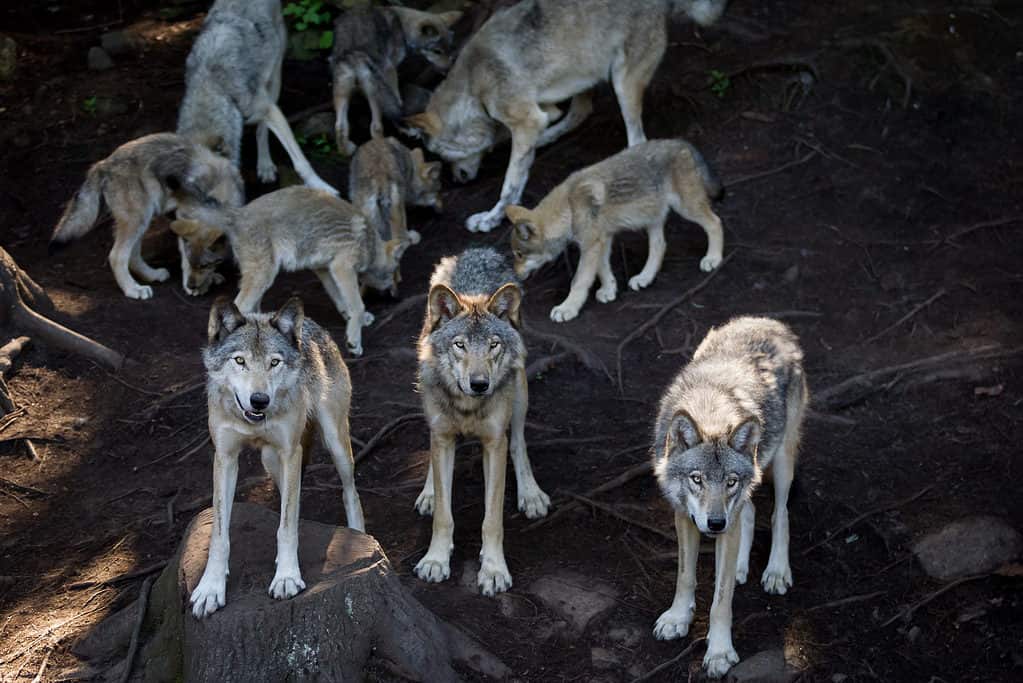
The pack of 50 wolves would win a fight against a pride of lions mainly due to their numerical advantage.
©PatrickLauzon photographe/Shutterstock.com
What Animals Could Defeat 50 Wolves?
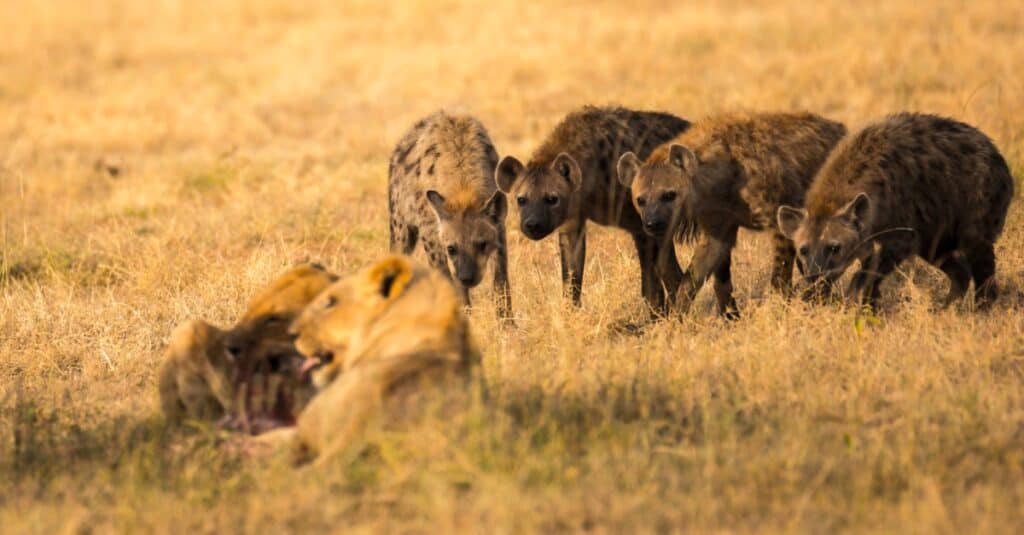
Hyenas regularly contend with lions, so wolves would not be much more difficult for them to defeat.
©iStock.com/Staincliffe
A pack of wolves 50 members strong may seem like an undefeatable team when paired against a pride of lions, but there are many other highly synchronized groups of predators in nature that could take part in a truly epic battle against these canines. Hyenas are one such opponent. While both creatures may be equally matched when it comes to stats like size, and speed, as well as clear communication and loyalty to their packs, hyenas have much stronger bite forces. In the ensuing confrontation, hyenas would be able to deal a lot more damage a lot faster than the wolves could keep up. Since the size of a cackle of hyenas can reach up to 100 members, they could easily outnumber the wolves as well. If the wolves tried to retreat at this point, the hyena’s slight advantage of 5 mph in max speed would be all that they needed to emerge from the fight victorious.
The photo featured at the top of this post is ©
Sources
- PBS, Available here: https://www.pbs.org/wnet/nature/blog/lion-fact-sheet/
- ScienceDirect, Available here: https://www.sciencedirect.com/science/article/abs/pii/S0003347298908843
- The National Wildlife Federation, Available here: https://www.nwf.org/Educational-Resources/Wildlife-Guide/Mammals/Gray-Wolf
Thank you for reading! Have some feedback for us? Contact the AZ Animals editorial team.






